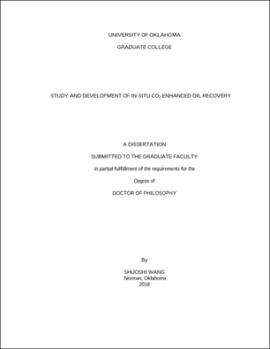| dc.description.abstract | While the injection of CO2 has great potential for increasing oil production, this potential is limited by site conditions and operational constraints such as the lack of proper infrastructure, limited cheap CO2 sources, viscous fingering, gravity override at the targeted zones, and others. The alternative methodologies which can successfully deliver CO2 through gas generation in situ, with superior improved oil recovery (IOR) performance, while offering reasonable chemical cost is explored to mitigate some of these common limitations.
In this study, the ammonium carbamate and urea are considered as the new compounds capable of generating CO2 in situ. Their self-reaction ignition properties make the single fluid injection possible and reduce the complexity of the injection system. With exceptional water solubility (up to 40 wt.% for ammonium carbamate and 50% for urea at room temperature), ammonium carbamate and urea can be thermally endothermically hydrolyzed to CO2 and NH3 after equilibration under reservoir conditions. Because of their CO2 producing capacity and reasonable cost-benefit, they appear to be a promising candidate for delivering CO2 to increase oil recovery.
In this work, the performance of injected aqueous chemical solutions was evaluated in a series of bench experiments to mimic tertiary oil recovery (perform test after the residual oil saturation was established by water flooding). One-dimensional sand pack tests and core flooding experiments were operated at different pre-set conditions: the flow rate varied from 0.03 to 0.3 ml/min, CO2 generating chemical concentrations from 1 to 35 wt%, pressures from 0 to 4000 psig, , temperature from 80 to 133℃ and different API gravity oils were used, varying from 27 to 57.3.
The eluted crude oil and brine samples from these tests were collected and analyzed to assess the change of oil properties and brine chemistry influenced by the thermally produced CO2 and NH3. In addition, the reaction rates of urea hydrolysis were tested separately using a microwave reactor to compare the kinetics of urea hydrolysis reactions via varying reaction temperatures.
Most importantly, results of injecting chemical solution (as low as 1 % solution) showed tertiary recovery performance (as high as 50%) as compared to the similar in situ CO2 generation EOR(2.4% to 18.8%) approaches proposed by others. Because of the reservoir brine compatibility of urea, even under high levels of divalent ions( Ca+2 7000 ppm), the experiment showed no detectable effect of brine composition on the recovery and/or any occurrence of formation damage. The post-reacted solution showed a solution pH about 10 because of the formation of NH3 (and NH4OH). Compositional analyses of the eluted oil also revealed different trends as compared to typical CO2 flooding, indicating additional benefits of this new CO2 delivery method resulted from the produced ammonia and its impact on the wettability of the solid surfaces. The economic feasibility and operational advantages of this newly developed method were demonstrated in this work. In brief, results of this work served further as a proof of concept for designing in situ CO2 generation formulations for tertiary oil recovery at both onshore and offshore fields under proper conditions. It can be a guide to select the suitable reservoir condition, oil property, chemical concentration and injection strategy. | en_US |
